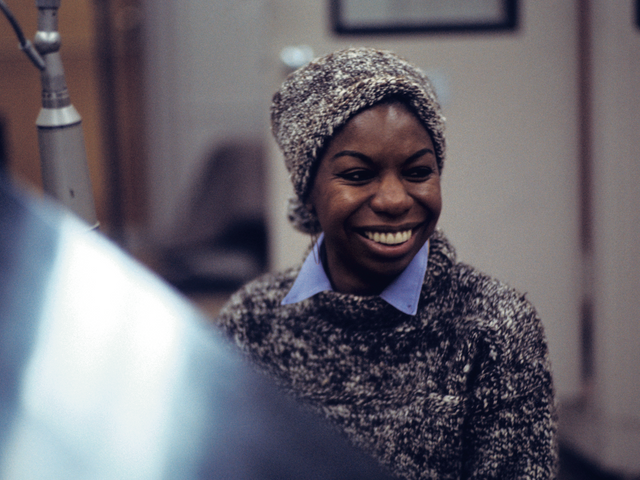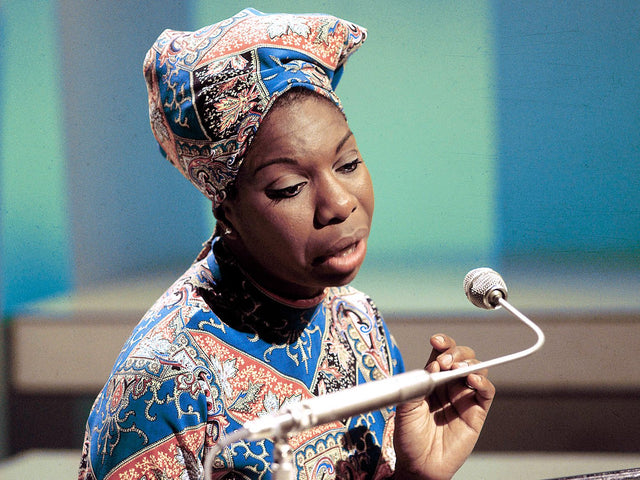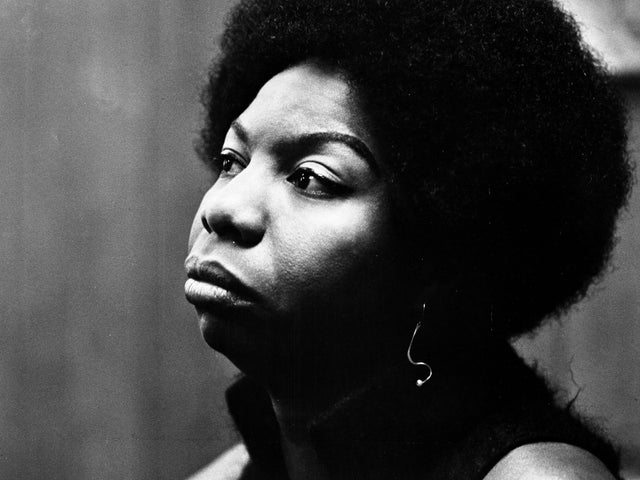The 10 Best Nina Simone Albums to Own on Vinyl
You've Got Nina Simone Sings the Blues Coming, Here Are 10 More Nina Albums to Grab
During my quest to read every Nina Simone book and watch every Nina Simone movie, I found out that none of those pieces of media were pausing to tell you about which albums by her were the best. She released close to 50 studio and live albums during her proper career, and the amount of compilations and unofficial albums from shady labels brings that number closer to 75. We think Nina Simone Sings the Blues is the best Nina Simone album, but we don’t think the Nina part of your collection should stop there. So here are the 10 Best Nina Simone Albums to Own on Vinyl.

Little Girl Blue (1958)
Nina’s debut album would be a sore spot for her in the early days of her singing career; after some years on the club circuit after she failed to be accepted to a couple classical music programs, she got some fame as her arrangement of “I Loves You, Porgy” became a huge hit. Her label, Bethlehem, rushed her into the studio to record this album—her purest jazz vocalist album—and convinced her to sign over the rights to all of the songs here for $3,000, which, after “Porgy” stayed big, and after “My Baby Just Cares for Me” became an enormous hit in the 1980's thanks to a Chanel No. 5 ad, ended up costing her millions of dollars in royalties. You get a glimpse of the different direction Nina could have taken her music if she resolved to stay famous as just a jazz pianist; this is the smoothest, most cocktail hour ready album in her discography.

Nina Simone in Concert (1964)
In early 1964, Nina signed with Philips Records, who released this album as her first for them. Comprised of songs from three performances at Carnegie Hall in 1964, this album is notable for its obvious shift by Nina into Civil Rights Activism, as she became less concerned with appealing to people who liked “I Loves You, Porgy,” and more concerned with chronicling the reality of the movement happening in America. This album features her most lasting Civil Rights Anthem, “Mississippi Goddam” in a more jocular form than she’d perform it later, but its words still hit harder than any speech could. She also morphs “Pirate Jenny” from Threepenny Opera into an allegory for Civil Rights, rendering the song more impactful and incredible than the original. For document of Nina being a powerhouse live, look no further.

I Put a Spell on You (1965)
Nina Simone’s place in “classic rock” and “classic soul” canon is sometimes unjustly relegated to two songs from this album: her symphony-backed cover of “I Put a Spell on You” and “Feeling Good,” the song of hers that’s been streamed more than any other. Nina’s career is too unwieldy and too varied to be reduced to a single album, or a single song, which is why it’s so hard for people to dive into her discography. You don’t know where to start. That said, this album is an easy toe-dip, since those two aforementioned songs are the ones everyone’s parents know. Get this as an accompaniment to Nina Simone Sings the Blues, but don’t let your Nina collection end here.

Pastel Blues (1965)
We know you’re getting Nina Simone Sings the Blues, but if we can demand you own at least one more Nina Simone record, let it be this one. Along with Sings the Blues, this is the most “complete” Nina album, a record that showcases her jazz stylings, her ability to sing blues so deep and impactful, and the songs of protest that became more important to her than anything else she was doing (and more important to her audience). This album has her virtuosic, 10-minute take of “Sinnerman,” a traditional African American spiritual song, and her iconic cover of “Strange Fruit,” which came back in a big way when it was used on Yeezus. You also get “Be My Husband,” a song that is just Nina’s voice and light percussion, a testament to the power of her voice that it sounds like an army of musicians making the song have its heft. Your collection is incomplete without this album.

High Priestess of Soul (1967)
A mixture of African American folk and gospel songs, and original compositions that sound like them, High Priestess of Soul is one of Nina’s most boisterous albums; she’s at home belting out over the horn sections and backing choirs here. It was her last album for Philips, and she’d never do music that sounded as tied to the constructs of pop soul ever again. That doesn’t mean this isn’t essential; it’s got some of her most incredible original compositions, like “Take Me to the Water.”

Silk & Soul (1967)
Silk & Soul is the direct follow up to Nina Simone Sings the Blues, and it represents a side of Nina’s career that gets some short shrift; her open competition with artists like Diana Ross and Aretha Franklin, who often covered the magazines of the African American media, and who sold many more records than Nina did.* Silk & Soul* is the most pure soul album Nina made in her whole career, and she even got nominated for a Best R&B Performance Grammy for “Go to Hell” off this album, which she lost to Franklin. But it’s also a testament to how even when Nina tried to go at the commercial kingpins of her generation, she still made sure to include songs like her unbelievable take of “I Wish I Knew How it Would Feel to Be Free.”

‘Nuff Said (1968)
A combo live/studio album, ‘Nuff Said captures Nina at the 1968 Westbury Music Fair, performing songs by the Bee Gees (“Please Read Me” and “In the Morning”), and songs from Nina Simone Sings the Blues to an adoring audience. This one has gained a lot of current popular culture relevance just this year however, since Kanye West sampled “Do What You Gotta Do” for the Rihanna-featuring “Famous.”

A Very Rare Evening (1969; Wasn’t Released Until 1979)
We need to include at least one crate-digger special on this list. Considered one of the rarest Nina Simone albums, this live set was released on the tiny PM Records in 1979, and was comprised of recordings Nina made in 1969 in Europe. It features incredible covers of songs by Aretha, the Byrds, Pete Seeger, and more, and was out of print in the U.S. from 1979 until it got reissued by Tidal Waves Music this year.

Here Comes the Sun (1971)
An underrated part of Nina’s abilities as a performer was her ability to complete dismantle and recontextualize iconic pop songs of the day. She wasn’t covering obscure songs; she was doing huge huts, and once Nina got hold of a song, it no longer sounded anything like the original. It was hers now. There’s no better illustration of this than her cover of “My Way” from this 1971 album, where she deconstructs the song, changes the tempo, and renders it entirely different than the version Paul Anka wrote. She does the same to the George Harrison title track, and to Bob Dylan’s “Just Like a Woman” here.

Baltimore (1977)
In 1974, Nina Simone released* It Is Finished*, her last album for RCA, and what was widely reported as her last album, period. But predictably, when she came back from her sojourns abroad and wanted to drum up publicity, she hit the studio again, being signed to CTI, a small label run by jazz producer Creed Taylor. Simone would register displeasure at the album in her later years, decrying its reggae-influenced production, but this another Nina album that got retroactive fame, after the title track from this—a Randy Newman cover—gained poignance during last year’s protests in Baltimore. That a song from one of her last studio albums could find a new lease on life after the fact as a protest anthem is yet another tribute to Nina’s greatness.
Andrew Winistorfer is Senior Director of Music and Editorial at Vinyl Me, Please, and a writer and editor of their books, 100 Albums You Need in Your Collection and The Best Record Stores in the United States. He’s written Listening Notes for more than 30 VMP releases, co-produced multiple VMP Anthologies, and executive produced the VMP Anthologies The Story of Vanguard, The Story of Willie Nelson, Miles Davis: The Electric Years and The Story of Waylon Jennings. He lives in Saint Paul, Minnesota.
Join the Club!
Join Now, Starting at $44Exclusive 15% Off for Teachers, Students, Military members, Healthcare professionals & First Responders - Get Verified!







